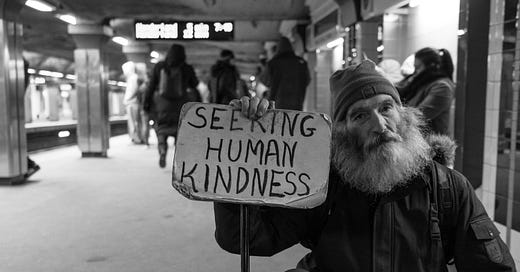To See and Be Seen
Luke 10:25–37
Some words in Scripture are dangerous. Not because they’re violent or provocative, but because they disrupt. They unsettle us. They dissolve the illusions we’ve spent years constructing about who we are, who belongs, and what matters most.
The parable of the Good Samaritan is one of those dangerous words.
Often reduced to a moral tale about kindness, the story actually cuts deeper. It’s not just a lesson in charity. It’s a call to conversion. A reorientation of identity. A disruption of the boundaries we draw, often unconsciously, between us and “them.” Between who we think we are and who God calls us to be.
It starts with a question: “What must I do to inherit eternal life?” Jesus affirms: “Love God. Love your neighbor.” But the man presses: “And who is my neighbor?”
In other words: Where does my responsibility end? Who can I ignore?
Jesus doesn’t offer a definition. He tells a story. A man is left beaten and half-dead on the side of the road. A priest sees him and passes by. A Levite does the same. Then, a Samaritan (someone despised by the religious elite) stops. He sees the wounded man, draws near, treats his wounds, carries him to safety, and pays for his care.
Then Jesus asks, “Which of these was a neighbor to the man?”
The answer is simple: “The one who showed him mercy.” And Jesus responds, “Go and do the same.”
Notice the shift. The man wanted to know who counts as a neighbor. Jesus flips the question. The real issue is not who is your neighbor, but will you be one?
As liberation theologian Jon Sobrino writes, “The neighbor is the one who makes ‘us’ possible, the one who makes the table shared.” In other words, we do not become fully human in isolation. We become who we are through our willingness to draw near.
René Girard adds further insight. Human communities often form by excluding someone. We bond over shared enemies. The priest and Levite may not be cruel, but their identities depend on avoiding contamination and maintaining status. Their passing by is a symptom of a system that survives through distance.
Jesus breaks this pattern. The Samaritan doesn’t just see a need. He sees himself in the wounded man. He crosses the road, and in doing so, crosses every expectation.
Gustavo Gutiérrez calls this “conversion to the neighbor.” The neighbor is not just someone we happen to encounter. It is someone we deliberately approach. Not just a moral choice, but a change in geography and presence.
Neighboring is not soft work. It is not just volunteering or offering help from afar. It is costly, interruptive, and risky. It is a discipline that says, “I will move toward the pain. I will not look away.”
If we want to be where Jesus is, we must go where the pain is. Because Jesus is not perched in places of comfort. He is in the ditch, among the broken.
So go. See. Be seen. Love not from a distance, but from up close. That is where the kingdom lives.
And that is where you’ll find yourself.




